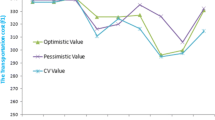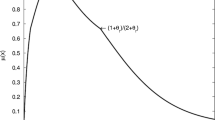Abstract
The transportation problem (TP) is an important supply chain optimization problem in the traffic engineering. This paper maximizes the total profit over a three-tiered distribution system consisting of plants, distribution centers (DCs) and customers. Plants produce multiple products that are shipped to DCs. If a DC is used, then a fixed cost (FC) is charged. The customers are supplied by a single DC. To characterize the uncertainty in the practical decision environment, this paper considers the unit cost of TP, FC, the supply capacities and demands as Gaussian type-2 fuzzy variables. To give a modeling framework for optimization problems with multifold uncertainty, different reduction methods were proposed to transform a Gaussian type-2 fuzzy variable into a type-1 fuzzy variable by mean reduction method and CV reduction method. Then, the TP was reformulated as a chance-constrained programming model enlightened by the credibility optimization methods. The deterministic models are then solved using two different soft computing techniques—generalized reduced gradient and modified particle swarm optimization, where the position of each particle is adjusted according to its own experience and that of its neighbors. The numerical experiments illustrated the application and effectiveness of the proposed approaches.










Similar content being viewed by others
Explore related subjects
Discover the latest articles, news and stories from top researchers in related subjects.References
Hirsch WM, Dantzig GB (1968) The fixed charge problem. Nav Res Logist Q 15:413–424
Hitchcock FL (1941) The distribution of a product from several sources to numerous localities. J Math Phys 20:224–230
Chanas S, Kolosziejczyj W, Machaj A (1984) A fuzzy approach to the transportation problem. Fuzzy Sets Syst 13:211–221
Effati S, Pakdaman M, Ranjbar M (2011) A new fuzzy neural network model for solving fuzzy linear programming problems and its applications. Neural Comput Appl 20(8):1285–1294
Mortazavi A, Khamseh AA, Naderi B (2015) A novel chaotic imperialist competitive algorithm for production and air transportation scheduling problems. Neural Comput Appl. doi:10.1007/s00521-015-1828-9
Fegad MR, Jadhav AV, Minley AR (2011) Finding an optimal solution of transportation problem using interval and triangular membership functions. Eur J Oper Res 60:415–421
Karnik NN, Mendel MJ (2001) Centroid of a type-2 fuzzy set. Inf Sci 132:195–220
Liu F (2008) An efficient centroid type-reduction strategy for general type-2 fuzzy logic system. Inf Sci 178:2224–2236
Chen S, Chang Y (2011) Fuzzy rule interpolation based on the ratio of fuzziness of interval type-2 fuzzy sets. Expert Syst Appl 38:12202–12213
Melin P, Castillo O (2013) A review on the applications of type-2 fuzzy logic in classification and pattern recognition. Expert Syst Appl 40:5413–5423
Yang L, Liu P, Li S, Gao Y, Ralescu Y (2015) A Reduction methods of type-2 uncertain variables and their applications to solid transportation problem. Inf Sci 291:204–237
Yang L, Zhou X, Gao Z (2014) Credibility-based rescheduling model in a double-track railway network: a fuzzy reliable optimization approach. Omega 48:75–93
Liu P, Yang L, Wang L, Li S (2014) A solid transportation problem with type-2 fuzzy variables. Appl Soft Comput 24:543–558
Tavoosi J, Suratgar AA, Menhaj MB (2015) Stability analysis of recurrent type-2 TSK fuzzy systems with nonlinear consequent part. Neural Comput Appl. doi:10.1007/s00521-015-2036-3
Zoveidavianpoor M, Gharibi A (2015) Applications of type-2 fuzzy logic system: handling the uncertainty associated with candidate-well selection for hydraulic fracturing. Neural Comput Appl. doi:10.1007/s00521-015-1977-x
Tavoosi J, Badamchizadeh MA (2013) A class of type-2 fuzzy neural networks for nonlinear dynamical system identification. Neural Comput Appl 23(3):707–717
Coupland S (2007) Type-2 fuzzy sets: geometric defuzzification and type-reduction. Found Comput Intell 1:622–629
Qin R, Liu Y, Liu Z (2011) Methods of critical value reduction for type-2 fuzzy variables and their applications. J Comput Appl Math 235:1454–1481
Figueroa JC, Hernndez G (2012) A transportation model with interval type-2 fuzzy demands and supplies. Lecture notes in computer science, vol 1. pp 610–617
Kundu P, Kar S, Maiti M (2014) A fixed charge transportation problem with type-2 fuzzy variables. Inf Sci 255:170–186
Abdullah L, Najib L (2014) A new type-2 fuzzy set of linguistic variables for the fuzzy analytic hierarchy process. Expert Syst Appl 41:3297–3305
Jana DK, Das B, Maiti M (2014) Multi-item partial backlogging inventory models over random planninghorizon in random fuzzy environment. Appl Soft Comput 21:12–27
Kennedy J, Eberhart R (1995) Particle swarm optimization. In: Proceedings of the IEEE international conference on neural networks, Perth, Australia, vol 1. pp 1942–1945
Pedrycz A, Dong F, Hirota K (2011) Nonlinear mappings in problem solving and their PSO-based development. Inf Sci 181:4112–4123
Sadeghi J, Sadeghi S, Niaki STA (2014) Optimizing a hybrid vendor-managed inventory and transportation problem with fuzzy demand: an improved particle swarm optimization algorithm. Inf Sci 272:126–144
Koulinas G, Kotsikas L, Anagnostopoulos K (2014) A particle swarm optimization based hyper-heuristic algorithm for the classic resource constrained project scheduling problem. Inf Sci 277:680–693
Zadeh LA (1975) The concept of a linguistic variable and its application to approximate reasoning—I. Inf Sci 8:199–249
Li C, Yi J, Wang M, Zhang G (2013) Monotonic type-2 fuzzy neural network and its application to thermal comfort prediction. Neural Comput Appl 23(7):1987–1998
Acknowledgments
Authors thank the anonymous referees for their valuable comments and suggestions that helped to improve this paper.
Author information
Authors and Affiliations
Corresponding author
Rights and permissions
About this article
Cite this article
Jana, D.K., Pramanik, S. & Maiti, M. Mean and CV reduction methods on Gaussian type-2 fuzzy set and its application to a multilevel profit transportation problem in a two-stage supply chain network. Neural Comput & Applic 28, 2703–2726 (2017). https://doi.org/10.1007/s00521-016-2202-2
Received:
Accepted:
Published:
Issue Date:
DOI: https://doi.org/10.1007/s00521-016-2202-2




